Related Research Articles

The history of Atlanta dates back to 1836, when Georgia decided to build a railroad to the U.S. Midwest and a location was chosen to be the line's terminus. The stake marking the founding of "Terminus" was driven into the ground in 1837. In 1839, homes and a store were built there and the settlement grew. Between 1845 and 1854, rail lines arrived from four different directions, and the rapidly growing town quickly became the rail hub for the entire Southern United States. During the American Civil War, Atlanta, as a distribution hub, became the target of a major Union campaign, and in 1864, Union William Sherman's troops set on fire and destroyed the city's assets and buildings, save churches and hospitals. After the war, the population grew rapidly, as did manufacturing, while the city retained its role as a rail hub. Coca-Cola was launched here in 1886 and grew into an Atlanta-based world empire. Electric streetcars arrived in 1889, and the city added new "streetcar suburbs".
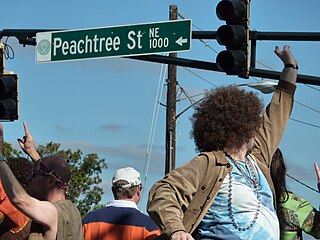
Peachtree Street is one of several major streets running through the city of Atlanta. Beginning at Five Points in downtown Atlanta, it runs North through Midtown; a few blocks after entering into Buckhead, the name changes to Peachtree Road at Deering Road. Much of the city's historic and noteworthy architecture is located along the street, and it is often used for annual parades,, as well as one-time parades celebrating events such as the 100th anniversary of Coca-Cola in 1986 and the Atlanta Braves' 1995 World Series victory.
William Arnold Hemphill was an American businessman and politician.

Courtland Simmons Winn (1863–1940) was a politician, lawyer, and civic leader from the State of Georgia.
William M. Butt (1805–1888) was a politician in Georgia.
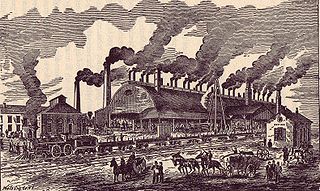
The Atlanta Rolling Mill was constructed in 1858 by Lewis Schofield and James Blake and soon after, Schofield and William Markham took it over and transformed it into the South's second most productive rolling mill, after the Tredegar Iron Works in Richmond, Virginia.
Franklin Miller Garrett was the only official historian of Atlanta. His massive Atlanta and Environs: A Chronicle of its People and Events is a book about the city's history.
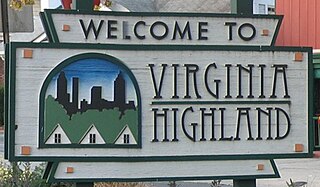
Virginia–Highland is an affluent neighborhood of Atlanta, Georgia, founded in the early 20th century as a streetcar suburb. It is named after the intersection of Virginia Avenue and North Highland Avenue, the heart of its trendy retail district at the center of the neighborhood. The neighborhood is famous for its bungalows and other historic houses from the 1910s to the 1930s. It has become a destination for people across Atlanta with its eclectic mix of restaurants, bars, and shops as well as for the Summerfest festival, annual Tour of Homes and other events.
From its incorporation in 1847, the municipal boundaries Atlanta, Georgia were extended repeatedly from a small area around its railroad station to today's city covering 131.7 square miles (341 km2).
The Atlanta graft ring was a corruption scandal that erupted in 1930 which generated 26 indictments and earned a Pulitzer Prize for the Atlanta Constitution newspaper.
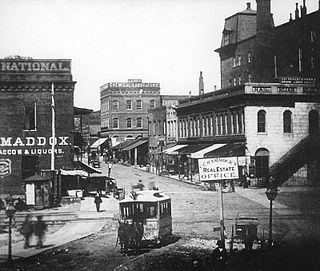
Streetcars originally operated in Atlanta downtown and into the surrounding areas from 1871 until the final line's closure in 1949.

Captain Augustus M. Reinhardt (1842–1923) was the namesake of Reinhardt University in Waleska, Georgia and a founder of Atlanta's Gate City Street Railroad Company. He was a Confederate war veteran, and had been a lawyer, city councilman and mayor pro tem.
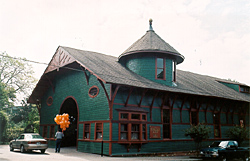
The Atlanta & Edgewood Street Railroad Company of Atlanta, Georgia was organized in 1886 by Joel Hurt, C. W. Hubner, H. E. W. Palmer, W. P. Inman, Peter Lynch, R. C. Mitchell, Asa Griggs Candler, J. P. McDonald, J. G. Reynolds, A. F. Moreland, and P. H. Harralson. It was originally authorized to run horsecars along Foster Street to what was then the separate village of Edgewood.
Dr. Henry Lumpkin Wilson was a prominent Atlanta physician, city councilman, and was active in the city's expansion and development.
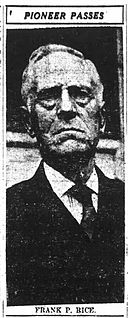
Franklin "Frank" P. Rice was an investor, businessman and local politician in Atlanta, Georgia.
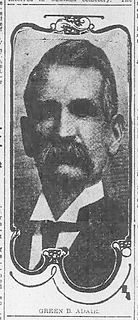
Green Buren Adair was a prominent Atlanta cotton merchant who conducted business in Atlanta from the Civil War until the turn of the 20th century. He was a cousin of George Washington Adair, another prominent real estate mogul in Atlanta.

Edward Conyngham Peters was an Atlanta real estate developer. He was the son of Richard Peters, a founder of the city.
William Wirt Clayton (1812–1885) was the son of noted Georgia politician Augustin Smith Clayton. In Atlanta, Georgia, W. W. Clayton became a judge, director of the Western and Atlantic Railroad, tax collector for Fulton County, Georgia and an officer of the Georgia National Bank.
The History of Virginia–Highland, the Intown Atlanta neighborhood, dates back to 1812, when William Zachary bought and built a farm on 202.5 acres (0.819 km2) of land there. At some point between 1888 and 1890 the Nine-Mile Circle streetcar arrived,, making a loop of what are now Ponce de Leon Avenue, North Highland Avenue, Virginia Avenue, and Monroe Drive. Atlantans at first used the line to visit what was then countryside, including Ponce de Leon Springs, but the line also enabled later development in the area. Residential development began as early as 1893 on St. Charles and Greenwood Avenues, must most development took place from 1909 through 1926 — solidly upper-middle class neighborhoods, kept all-white by covenant.
References
- 1 2 Acts passed by the General Assembly of Georgia' 1883', p. 220
- ↑ Atlanta and Environs: A Chronicle of Its People and Events, 1880s-1930s By Franklin M. Garrett, p.103
- ↑ Atlanta and Environs: A Chronicle of Its People and Events, 1880s-1930s By Franklin M. Garrett, p. 490
- 1 2 Atlanta's Streetcars of the Nineteenth Century (blog)
- ↑ "Proposal to save trolley barns fails by one vote in council", October 20, 1987, Atlanta Journal and Constitution, Page A/28
- ↑ Citing asbestos, Young now wants trolley barns razed", October 17, 1987, Atlanta Journal and Constitution, Page Number: B/1